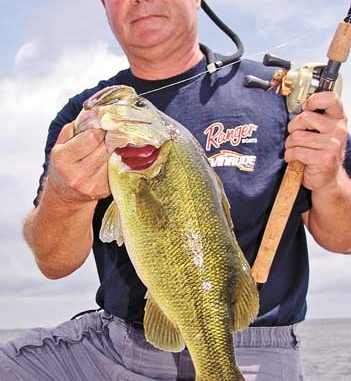
This perennial Black Bay hotspot is producing big trout and reds.
I love to fish the Delacroix area, especially Lake Lery, at any time of the year, but especially during July. If you fish around Delacroix this month, you’ll catch 20 or 30 bass and the same number of speckled trout and redfish.
Although I make my living as a professional bass fisherman, I also like to catch and eat specks and reds. I’ll put back the 4- to 5-pound bass from Delacroix, but those 1 1/2- to 2 1/2-pounders (bass, trout and reds) are my favorite fish to eat.
Delacroix is located on the east side of the Mississippi River. The diversion water from the Mississippi River comes through Lake Lery, so Delacroix is a brackish-water marsh and contains both saltwater and freshwater fish. The Caernarvon Diversion has created an explosion of bass in this area, and these bass can grow almost year-round. We call them butterbean bass, because they’re wide for their lengths.
In most lakes and rivers, the bass are the apex predators. But at Delacroix, they have to compete with speckled trout, redfish, flounder and other species for food. This competition makes the Delacroix bass attack savagely. Also, current seems to make bass feed more heavily, and this region has tidal movement.
Buzzing up Delacroix bass
Early in the morning, you just can’t beat buzzbait fishing on the edges of the grass at Delacroix. If the weather’s cloudy, overcast or rainy, you can fish the buzz bait until about noon.
I like to fish either the Strike King 3/8-ounce or 1/2-ounce buzz bait. Generally, I’ll fish the 1/2-ounce, because I can cast it farther and control it better than I can the 3/8-ounce. In July, the bass are feeding on mullet, shad and minnows, so I like either a white or white/chartreuse skirt.
I don’t think you can reel a buzz bait too fast in July to get the bass to bite. You’ll get many reaction strikes by reeling the buzz bait fast.
Use a trailer hook on your buzz bait. Sometimes, the bass will miss the head, and only hit the tail end of the lure, or they’ll slap at it, and that trailer hook will catch them.
I’ll fish the buzz bait using a Quantum PT Series 6:1 gear-ratio reel with 30-pound-test Cajun Braid line that will catch a bass, a speckled trout or a 15-pound redfish. I like the Quantum Signature Series Kevin VanDam 6-foot, 10-inch spinnerbait rod in heavy grass; however, in sparse grass, I prefer a 7-foot Quantum Energy rod.
Catching bass with frogs
This time of year, we’ll have some of those really hot, slick days, with no wind. I’ll start fishing a hollow-bodied frog on those milfoil mats. In sparse grass, I prefer the Rage Toad.
I’ll use either 50- or 60-pound-test Cajun Braid line on a 7-foot, 2-inch Quantum Greg Hackney rod for a little-more backbone with either a 6:1 or even a 5:1 gear-ratio baitcasting reel to get the extra power I need to drag that bass to the boat. On some days, the bass want the frog to move fast across the grass, and other days they want the frog to sit still and make ripples.
Fishing the current
If I’m not catching the number of fish I think I should be catching with the buzz bait or the frog, then I’ll leave the heavy grass. I’ll look for current coming through the grass — particularly where the current has pushed the milfoil up against the bank and made a canopy for the bass to hide under or hyacinth patches through which the current moves.
I’ll fish with the Rodent or the Strike King Coffee Tube because both these baits will penetrate thick cover and get under the grass where the bass are holding. On a bright, sunny day that’s almost too hot for us to breathe, the bass will use cover and shade as ambush points to attack bait. When the bass are under the weeds, they become opportunistic predators.
If Delacroix’s water has a tannic-acid color, I like black neon and black/blue for the Rodent and the Coffee Tube. If the water’s clearer, I prefer watermelon/red flake or green/pumpkin. If the water’s very clear, I like junebug.
I’ll be flipping these lures on either 50-or 60-pound-test braided line, and use either a 1/2- or 3/4-ounce Tru-Tungsten sinker for milfoil that’s blown over on the edge of the bank. To punch through hyacinths, I’ll fish a 3/4-ounce sinker or up to a 1 1/2-ounce sinker. With the heavier weight, I prefer the 60- to 65-pound-test braided line.
But with the lighter weight, I’ll use 50-pound-test braided line for flipping. I use only Tru-Tungsten sinkers when I’m flipping because the Tru-Tungsten is smaller than lead, and it’ll punch through the vegetation much easier than lead will. I use the Quantum Greg Hackney 7-foot, 11-inch rod when I’m flipping and a Quantum 6:1 baitcasting reel. Flipping the grass, you’ve got a chance to catch a 5-pound bass or a 15-pound redfish.


